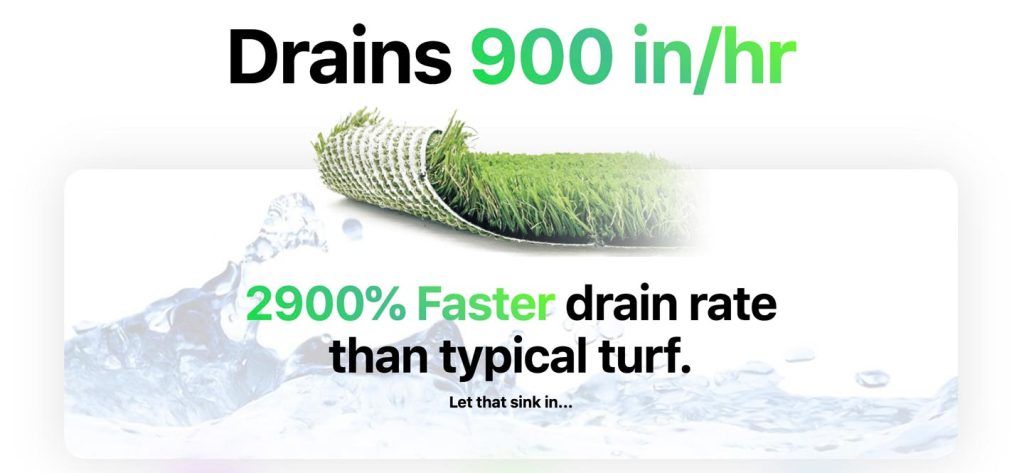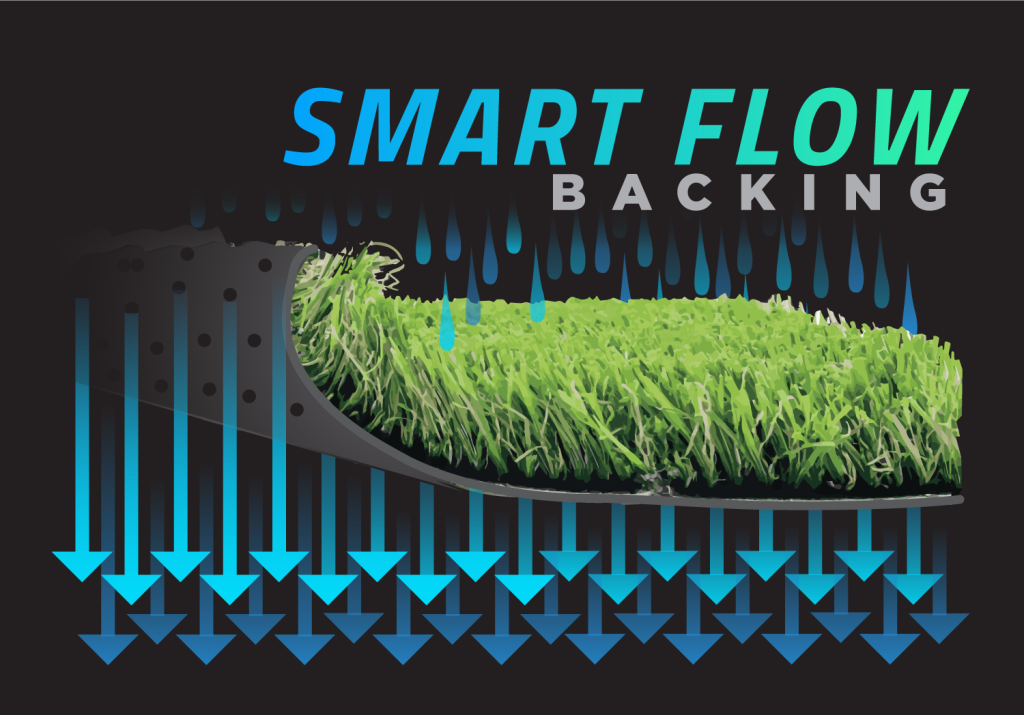When choosing artificial grass, one crucial—but often overlooked—feature is how well it handles water. If your turf can’t let rain, irrigation, or pet waste drain efficiently, you’ll risk puddling, odors, or turf degradation over time. That’s why Smart Flow, a proprietary drainage backing system from Smart Turf®, is such a standout.
Smart Flow is engineered to improve permeability, drainage, and long-term performance relative to conventional turf backing. In this post, we’ll dig into what turf permeability means, why it matters, how Smart Flow stacks up against traditional backing options, and what to look for if you’re specifying artificial turf for your project.
Why Turf Permeability Matters
What Is Permeability in Artificial Turf?
In the context of artificial grass, permeability (or infiltration) refers to the ability of water to pass through the turf system—through the fibers, infill, backing, and underlying base layers. In other words, how quickly does water migrate from the surface down into the drainage system or subsoil?
Technically, permeability is expressed as a flow rate (e.g. in inches per hour) under a hydraulic gradient. In practice, we often treat infiltration (vertical flow) and saturated permeability as equivalent when the system is fully saturated. Ymaws+1
A well-designed turf system should meet minimum permeability standards (for example, the turf + backing/infill layer is often expected to drain at 10 in/hr or more, per sports turf guidelines).
Why Good Drainage Is Essential
-
Prevents Water Pooling & Flooding. Poorly draining turf will trap water on the surface, leading to puddles, soggy patches, and unusable areas—especially after heavy rain.
-
Reduces Mold, Mildew & Bacterial Growth. Water that lingers encourages biological growth, especially in shaded or high-moisture zones.
-
Improves Turf Longevity. Moisture stress and saturation can degrade backing materials, adhesives, and bonding over time.
-
Hygiene & Pet-Friendly Use. In pet zones, urine and waste must drain quickly to avoid odor buildup; slow drainage can lead to health/hygiene complaints.
-
Regulatory Compliance & Stormwater Management. Some municipalities classify turf as “impervious” unless it meets certain permeability metrics. Using highly permeable turf helps comply with stormwater and runoff regulations.
-
Rapid Return to Use. In landscapes, rooftops, sports fields, or event venues, you want the surface to be usable soon after rainfall. Fast drainage ensures shorter downtime.
According to Turf Network, fully permeable “flow-through” backings can allow drainage across the entire surface—not just over discrete holes—leading to “hundreds of inches per hour” of capacity. Conventional hole-punch backings, by contrast, often depend on discrete perforations to drain.
| Feature / Metric | Smart Flow Backing | Conventional (Hole-Punch / Perforated) Backing |
|---|---|---|
| Drainage Type | Edge-to-edge, 100% permeable (flow-through) across the full surface | Perforated holes spaced at intervals (e.g. 4–6 in) |
| Drainage Rate | Very high—liquids drain uniformly | Good, but limited by hole spacing and opening size |
| Resistance to Clogging | Less risk of infill clogging since flow is across entire structure | Higher risk: infill particles or debris can block holes |
| Performance under full saturation | Maintains permeability across the area | May see bottlenecks or lateral flow to holes |
| Ideal Use Cases | Pet areas, playgrounds, sports fields, high rainfall zones | General lawns, moderate traffic, budget installations |
| Maintenance Requirements | Lower (less risk of clogged drainage paths) | Requires regular cleaning to keep perforations clear |
| Backing Structural Support | Engineered to support flow while maintaining strength | Conventional backing primarily structural with drainage holes |

Key Takeaways:
-
Smart Flow’s fully permeable backing ensures drainage across the entire surface, reducing the risk of localized saturation or clogging.
-
While hole-punch systems are proven and still widely used, their drainage is limited to discrete points and may struggle in high-demand or saturated conditions.
-
For installations in pet zones, rooftops, or high-intensity rain environments, a flow-through backing like Smart Flow often delivers more reliable performance over time.
How Smart Flow Works (Architecture & Technology)
Smart Flow integrates a backing system engineered to direct water rapidly through the turf surface. The design ensures that the entire backing structure is permeable—meaning that no matter where water (or pet waste) makes contact, there’s a drainage path.
This contrasts to traditional backing that uses drilled or punched holes. In those systems, water must find its way to one of the holes to escape; areas further from holes may temporarily saturate or even remain ponded until lateral flow occurs.
Smart Flow thus mimics the “fully permeable” or “flow-through” backings described in turf industry literature (such as by Turf Network) and offers performance improvements in drainage uniformity, clog resistance, and system resilience.
<<Watch how Smart Flow Works >>
Other Factors That Influence Turf Drainage Performance
While the backing is critical, it is only one part of the full turf drainage system. Here are other elements to pay attention to:
1. Sub-Base / Aggregate Layers
Even the best backing won’t work if the underlying base is impermeable. Turf systems usually require crushed stone, gravel, or aggregate layers that facilitate lateral and vertical flow. If the base becomes clogged or overcompacted, drainage will suffer.
2. Base Grading / Slope
A modest slope (e.g. 1–2%) helps guide water toward drains or edges. Flat installation, or reversals in grade, can lead to water stagnation.
3. Infill Material & Grading
The infill (sand, silica, crumb rubber, or other blends) must balance structural stability with permeability. If infill compacts too tightly or clogs backing, drainage is hampered.
4. Air / Unsaturated Conditions
When the system is not fully saturated (as is often the case early in rainfall), trapped air in pores can restrict flow. Over time, air must be purged to reach full saturated conductivity.
5. Installation Quality / Compaction
Overcompacted aggregate, poorly aligned backing seams, or improper interface between layers can create weak points prone to clogging or flow restriction.
6. Maintenance
Leaves, debris, soil, pet hair, organic matter, or grit can accumulate and reduce permeability, especially in perforated systems. Periodic brushing, rinsing, and infill replenishment are vital.
7. Edge Drainage & Perimeter Detailing
Even the best turf needs well-designed edge drains or collection systems to carry water away from the site—especially on impermeable subsoils.
When all these factors are well addressed, a high-performance backing like Smart Flow can deliver outstanding, enduring drainage performance.




